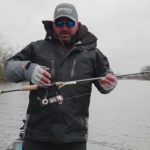Three Step Winter River Walleyes — Part 1
In the first of a three part winter river walleye series Scott Fairbairn shares some insight on effective vertical jigging technique.
 When applying this technique there are key concepts that need to be remembered in order to be consistently successful.
When applying this technique there are key concepts that need to be remembered in order to be consistently successful.
The biggest mistake that I see anglers making when vertical jigging is using a jig that is just too big. While it is always important to use the lightest jig possible while still maintaining bottom contact, it is even more critical during the cold-water period than at any other time. In cold water the walleyes strike zone and aggressiveness are significantly reduced. This means that you must make it easier for walleyes to eat your presentation. Which jig is the right size to use? The answer really depends on several factors including current speed, depth or simply how cold your fingers are. The point is to make sure you are trying to use the lightest jig possible to get the job done.
For many anglers this creates a catch-22. Using to large of a jig means you are going to miss fish, but going smaller may mean a loss of control. For those anglers that are having trouble go lighter, here are three options that might help make it easier.
If you are using monofilament line, switch to lines like Berkley Fireline or Spiderwire Stealth. These low stretch super sensitive lines provide greater feel, while at the same time offering drastically reduced line diameters for their break strength. The combination of these two effects will allow you to fish lighter jigs at greater depths in faster current. If you have not tried these lines for jigging remember there is one drawback. You don’t get to make the huge TV hook-sets that you might have needed with mono lines!
A second option for making things easier on the walleyes is to “bulk up” your jigs with soft plastic. When a walleye moves in to eat something it flares its gills and literally sucks the jig in like a vacuum. When you add soft plastic to your jig you essentially make it easier for the walleye to vacuum up your presentation. The plastic dramatically increases the surface area of your presentation without increasing the overall weight of the package. In short, you can make a quarter ounce jig as easy to eat as an eighth ounce jig simply by adding plastics!
As a last resort you can use stinger hooks to up your hooking percentage on these light biting fish. No doubt stinger hooks are an effective option. However, I have found that adding stingers will often decrease the number of bites I receive. I chalk it up to the stinger robbing the jig of some of its enticing action. Less bites but better hooking ratio? I’ll leave it up to you. I always try the other two options first.
There are many other important factors to consider when vertical jigging, but as stated previously, the most critical one is making sure that the package you present is something the walleye can actually easily eat.
In the next segment I will touch on an often overlooked counter option to vertical jigging. Sometimes pulling out a three-way rig and heading in the opposite direction is the right course of action. Stay tuned…
Every year on rivers throughout North America walleyes stage spectacular migrations upstream toward what will eventually become their spring spawning grounds. These migrations start in the fall with what some have termed as a “mock” spawning run and gradually crescendo towards the actual spawn sometime in March and April. While these migrations of walleyes are impressive, so can be the migration of walleye anglers who simply can’t wait for the regular open water season to arrive. The movement of these winter river anglers follows the same route as the walleyes during their winter meandering.
There are three key techniques that you must be ready to apply in order to consistently catch fish during the run. In this three part series I will cover what I like to call the river walleye three-step … three distinct techniques that will help you to catch more than your share of winter river walleyes.





